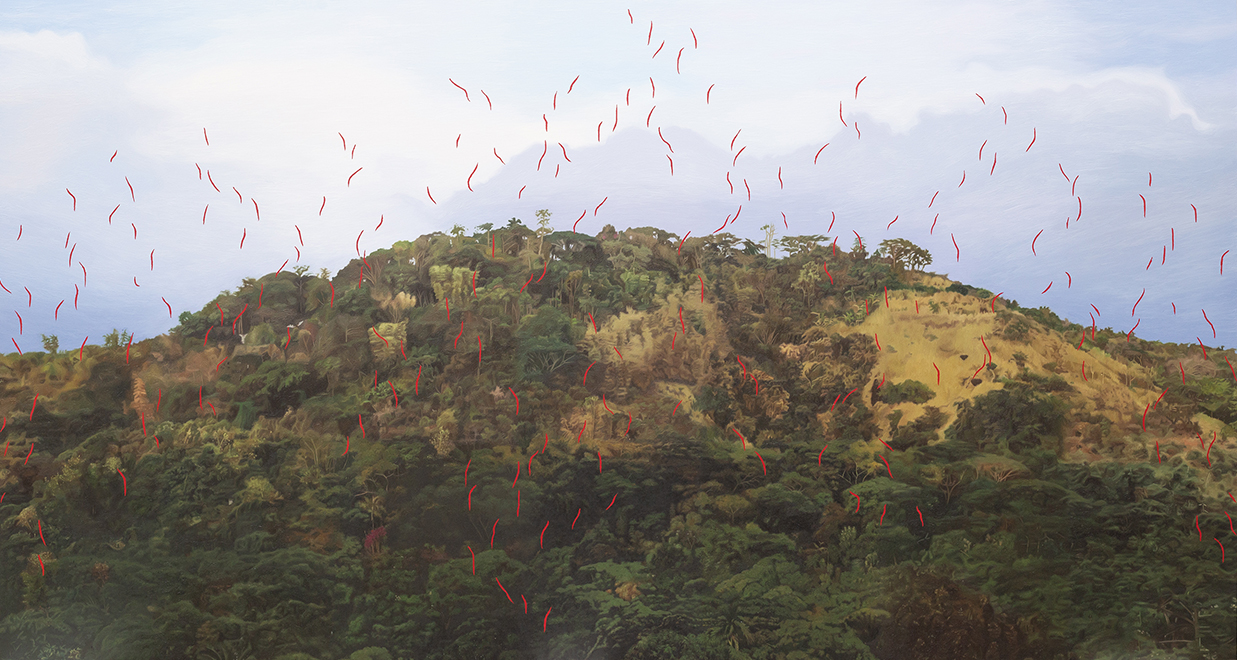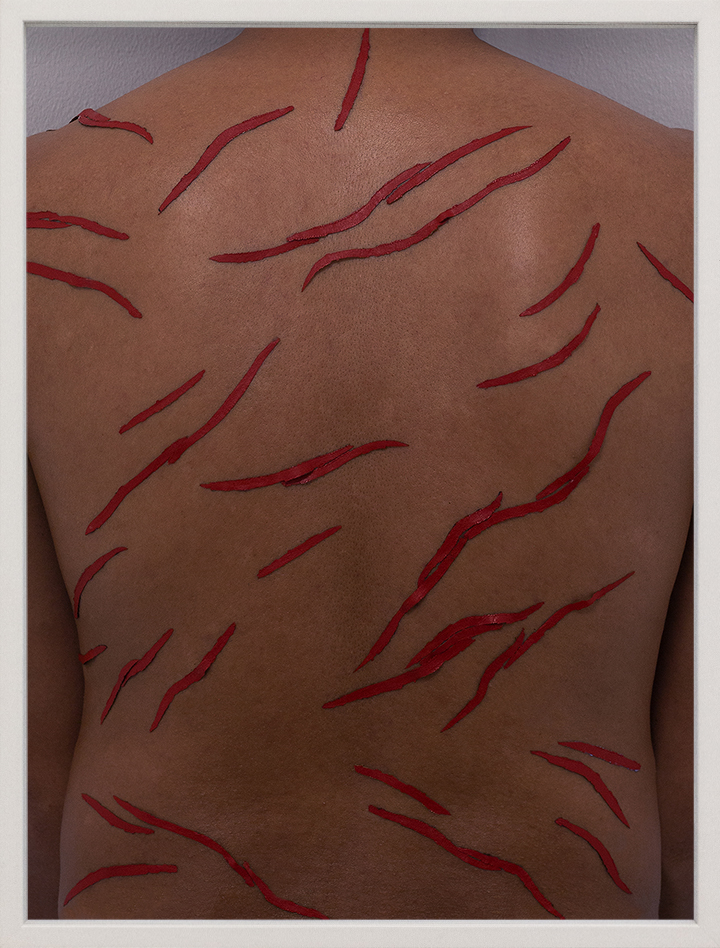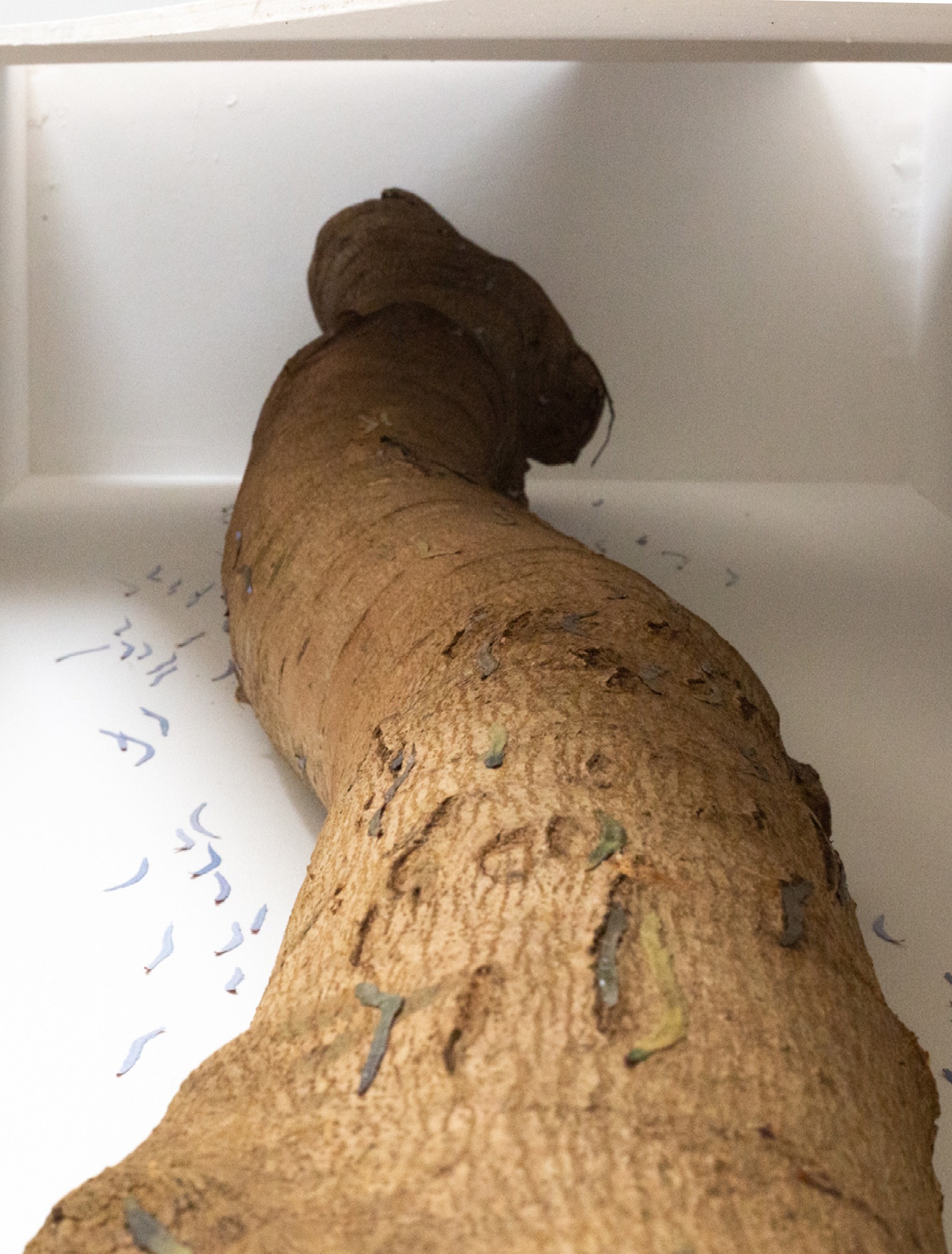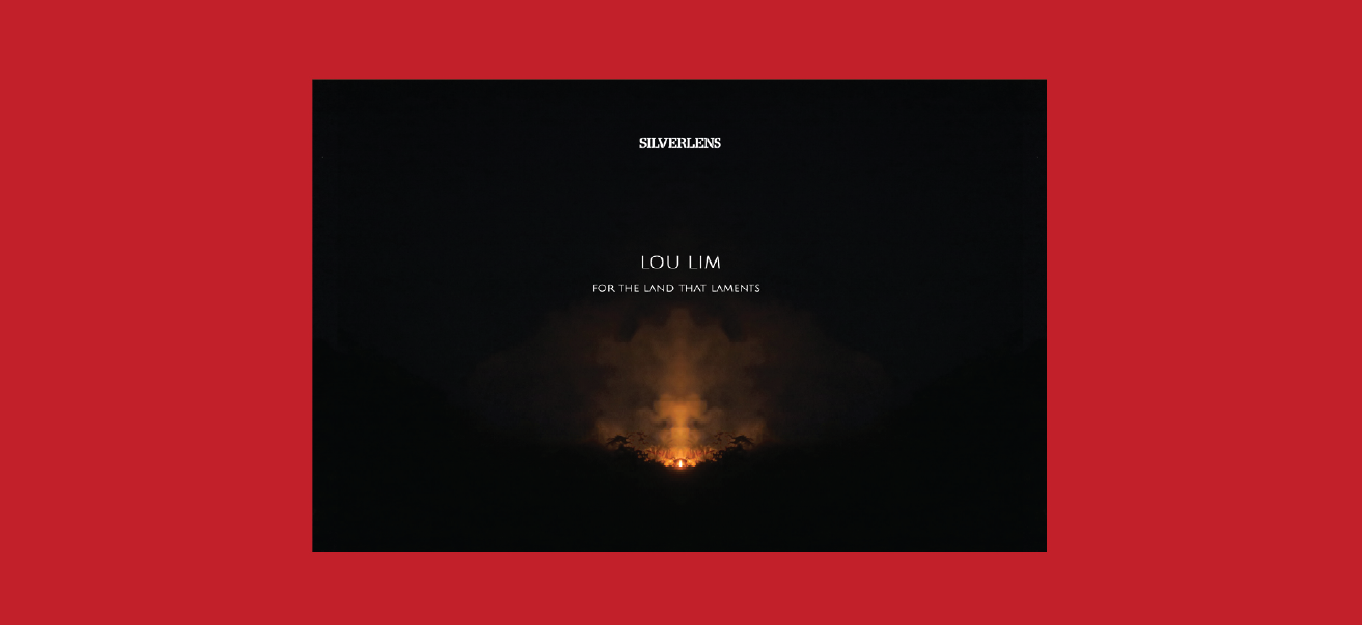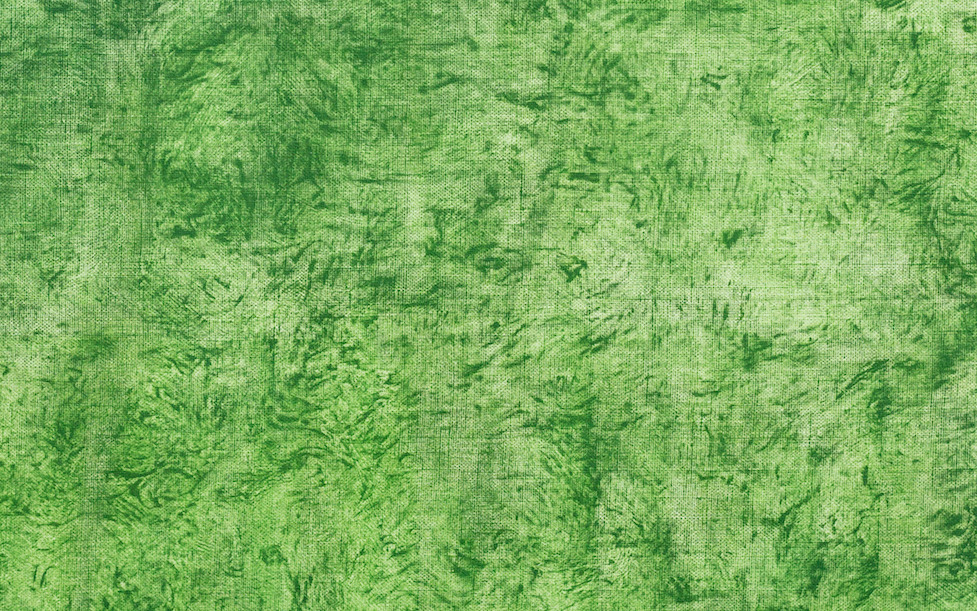
For the Land that Laments
Lou Lim
Silverlens, Manila
About
Silverlens is pleased to open its 2022 program with the show For the Land that Laments, a presentation of new works by recent CCP 13 Artists Awardee Lou Lim.
Lim returns for her second solo exhibition at the gallery with a brief selection of interrelated pieces, taking us deeper into her long-standing compulsion to employ sculptural gestures to investigate, challenge and reframe the materiality of painting.
The show’s central piece is a large-scale painting of a mountain, interrupted by hundreds of irregular, ‘squiggly’ red markings across the picture plane. Upon closer inspection, it becomes apparent that these markings, at once resembling wounds or tiny flames, were not painted over the finished picture. Indeed, they came to light by peeling off masking tape cut-outs that were laid out onto the empty canvas, set in place before the first dab of oil paint touched the fabric. For Lim, this act of ‘peeling’ is integral to the whole process, completing the work by subtracting material from the finished painting itself, as one might slowly chip away bits and pieces of stone when shaping a slab of marble.
As marble chips and similar offcuts are often gathered and saved for later reuse, the journey of the peels likewise continues as they take a brief detour to the body. Upturned, exposing their brick red undersides, they are carefully laid flat and photographed over a bare human torso, further amplifying notions of the wound. Soon after, they find rest on the surface of a fallen tree trunk found by the artist from the same mountain during a walk with her father. With their shared palette, these extracted bits of the painting seem to magically disappear into the tree, enveloping it like a second skin or a strange yet faithful camouflage.
- Gary-Ross Pastrana
Gary-Ross Pastrana: So Lou, Hello and congratulations on your new show.
Lou Lim: Thanks, Gary! Thanks for agreeing (again) to work with me on this show.
GRP: Maybe we can start our conversation talking a little bit about what you've been up to, since your last show, Horizon, at the gallery.
LL: That was in 2017! Can’t believe that was 4 years ago already.
GRP: Yes, but I guess the last two years were mostly overshadowed by the pandemic...
LL: The year after Horizon, I became quite busy. Aside from working full-time, it was also the first year I headed a ministry or a group in our church. So many other things happened, I even got sick and had to stay in the hospital for a while. But in terms of work, I continued with themes of the body being both corporeal and spiritual. I had solo exhibitions at West and Underground, and some group shows that we worked on together.
GRP: how did you cope with the pandemic and the prolonged lockdowns?
LL: I mostly stayed at home. I was worried about my parents, who are seniors and more vulnerable. Honestly, while I found it very difficult to work, I had no issues with isolation. I didn’t mind not being able to go out. The only problem is that, usually, my work starts with ‘looking’, and there’s really not much to see when you are just stuck at home.
GRP: Good thing that the mountain was right behind your house then!
LL: Yes! I just need to step out the door or climb up on the roof, and it’s there.
GRP: Can you talk a little bit more about this mountain? What’s your relationship with it and have you always considered using it for your work?
LL: Speaking about the pandemic, I’d say that I only really began to really notice the mountain during the lockdown, how it changes its color, from ochre yellow and browns in the summer to viridian green during the rainy season. But even before that somehow I knew that one day I’ll paint it, I was just waiting for the right motivation to do so. I think a lesson from a theology class about the strong association of men and trees made me decide to push through.
GRP: What’s the mountain called? And were you just looking for an image of a mountain that you can paint or was painting this particular mountain significant?
LL: It’s called Marian Hill and yes it’s important because of my familiarity and proximity with it and to what I consider to be my safe space.
GRP: Do you consider this show a continuation of Horizon? For people familiar with your work, the parallels will be quite evident in terms of subject matter and scale of the painting, the act of peeling, even the number of works...
LL: Yes, with also three works in the space. I think I said this in our last conversation, that I don’t usually plan what will come next. I also don’t like the pressure to connect or find a common thread in my works. But I guess going back to the same process is like repeating words from language so I can understand it more? What I’m really investigating here is the relationship of painting and sculpture, and fluidity of materials usually associated with them. I also like the space that the painting offers, that idea of the ‘out there’. The sculpture, on the other hand, is ‘right here’, something near and present, you can even walk around it. This tension allows me to further embrace their relationship.
GRP: What would you say to anyone who might be confused as to why anyone would ‘destroy’ an already perfectly executed painting by further subtracting elements from it?
LL: I don’t think anyone will, haha. But in any case, I think it’s just part of the democracy of looking at art. I never really thought that I’m destroying the painting by removing the ‘peels’, this for me actually completes it. But I get that there could be a certain discomfort in seeing a disrupted surface.
GRP: Can you give an overview of your painting process?
LL: I begin with an underpainting of red on the bare canvas, then I laid out a composition of the masking tape ‘peels’ on a separate, gridded transparent surface. When I’m happy with the composition, I then transfer the masking tape cutouts on the canvas before applying the primer. Only after will I start with the actual oil painting.
GRP: I see. This reminds me of your earlier works with skin.
LL: Yes, I made the peels in the same way I make the skin sculptures, by applying layers upon layers of industrial paints to make it thick enough to have “body”.
GRP: What’s the significance of the red underpainting?
LL: I chose it as I already knew by then that I will eventually use the peels to signify or resemble wounds, both on the mountain and the body.
GRP: I wrote this short line about the wounds after our last talk about this project: “Wounds not so much inflicted on the surface like a gash but bursting from within, cracking open the skin as the body releases the pressure it can no longer contain.”
LL: Yes, that’s nice. I was struggling to describe this feeling of the land letting off steam.
GRP: I also found some other notes that pertain to your idea of the land:
“For the artist, it is the land itself that is grieving, exasperated by the suffering that human beings inflict on each other. (With the recent slew of killings, at times perpetrated by those who swore to protect.)”
“…the now common practice of dumping bodies in shallow, hastily dug graves, in empty lots on the outskirts of the city.”
“…the image of mass graves, often discovered years after the fall of tyrannical regimes comes to mind. What the land is forced to swallow and keep, the darker secrets of each era.”
LL: It’s quite different, to be able to read it, thank you for putting this into words. This answers the “why” of the work, what I feel about our current situation. I was really getting depressed for a while, with all the news of EJK’s and other things happening under the guise of the drug war. I started to feel that our land is cursed, maybe from all the bloodshed. Perhaps, what we need is a kind of purging, but I didn’t know how to do that. I actually found it difficult to begin with this show, as I struggled with the feeling that whatever we do will be minuscule or insignificant, compared to the problem. I was hoping to find a way to ‘exorcise’ demons so to speak, or at least do something more relevant than being an artist during this time of crisis.
GRP: I’m glad you were able to push through all the negativity. I’m also acutely aware of the pressure you were in during this whole process. Yet I felt a kind of contrast in terms of disposition, as to how you performed the act of peeling in the gallery. You were really calm and sort of right there, present in the moment. Can you share your thoughts or add anything to this?
LL: I anticipated that this will be somewhat meditative, but when I was actually doing it, how can I describe it, it felt closer to purging or cleansing, in relation to healing. The title of the whole show and all the works in it is directed to the preposition “For”, a dedication to. It’s the first word in the title and something that was always in my mind while working. When I was peeling the painting, it was as if I was gathering what needs to be offered once I move to the human trunk, and finally to the tree.
GRP: Maybe we can talk about the tree? How did you arrive at this particular one?
LL: Factoring the size and shape, I was looking for something that resembles the presence of a body, not too thin, something that curves a little with a smooth outer layer and has some weight, I also like that it’s a Fire Tree. It just all came together as my father and I have long been scouting the area for a possible tree trunk, then a few weeks before the show, we saw this particular on the side of the road.
GRP: What’s the motivation for putting it in a box?
LL: For me, the value comes from how it relates to the passage “the stone has been rolled away”, referring to the resurrection.
GRP: Thanks Lou, congratulations again and good luck on the 13 Artists show. Excited to see what you come up with next.
Lou Lim (b. 1989) invests in the connection between the corporeal and the spiritual, between materiality and notions of permanence, between objects and visual imagery, and in what these relations articulate. Her works examine the processes and methods of different art forms to further investigate sculpture, creating new contexts for the familiar by exploring ideas and potentialities of surface and touch. Part of her methodology involves appropriating the medium of painting in creating or extracting sculptural forms, and vice versa: simulations of skin, the embodiment of phenomena such as horizons.
Lim earned her BFA from the University of the Philippines College of Fine Arts and has been actively exhibiting work since 2011. She was resident at Palais de Tokyo in Paris and the SeMA Nanji Residency in South Korea under the Pavillon Neuflize OBC 2015-2016 program. These participations resulted in a collaborative performance at the Opera de Paris and in group exhibitions at ICA Singapore and the Seoul Museum of Art in South Korea, as well as in a publication with INA [Institut National Audiovisuel].
Installation Views
Works
